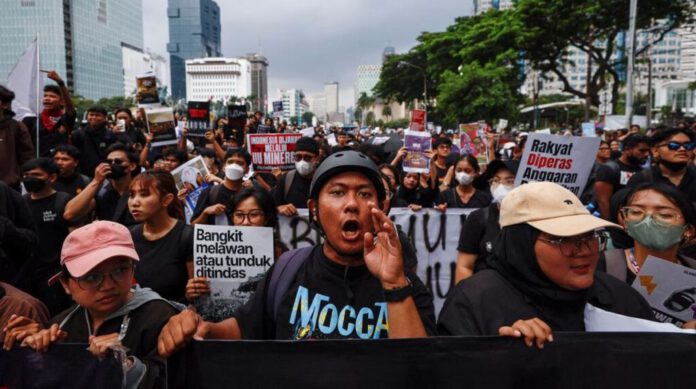
At the end of August 2025, Indonesia faced its most severe nationwide protests in nearly a decade. The immediate trigger was a controversial proposal to grant parliamentarians a monthly housing allowance of 50 million Indonesian rupiah (approximately $3,000)—ten times Jakarta’s minimum wage and twenty times that of impoverished regions. As many Indonesians grappled with soaring living costs, scarce employment opportunities, and tightened public budgets, this blatant favoritism toward the elite ignited long-simmering social frustrations.
Despite President Prabowo Subianto’s swift response, protests rapidly spread from Jakarta to 31 cities including Surabaya, Bandung, and Makassar. In some areas, demonstrations escalated into violent clashes, with protesters storming legislative buildings, setting fire to parliament offices, and looting officials’ residences. To quell the unrest and address the “17+8 People’s Demands,” Prabowo withdrew the subsidy proposal and replaced several lawmakers, as well as key ministers in the economic and security sectors.
This apparent crisis over economic redistribution reveals a deeper rupture in Prabowo’s governance—a fragile balance between coercion and concession. As a former army general, Prabowo’s style embodies a paradox: he seeks to maintain order through militarized authority while simultaneously courting public favor with populist policies. Yet, these dual strategies have faltered.

His emphasis on force has rekindled fears of authoritarian regression and state violence, while his populist gestures have floundered amid fiscal constraints and glaring inequalities. Neither approach has addressed Indonesia’s structural problems; instead, the imbalance has driven social discontent to a breaking point. This dynamic exposes the struggle of a young democracy caught between authoritarian tendencies and populist pressures.
Prabowo’s militarized approach is evident in the reshaping of Indonesia’s power structure. Upon taking office, he formed an unprecedentedly large cabinet, known as the “Red and White Cabinet,” filled disproportionately with military veterans, including key positions held by former generals. By granting honorary four-star ranks to retired officers and revising history textbooks to emphasize nationalist narratives while omitting references to past ethnic violence, Prabowo seeks to legitimize a centralized, military-backed political cartel.
His efforts to consolidate control over policy-making and bureaucracy reflect an attempt to create a loyal power base anchored in military loyalty. Concurrently, the government’s controversial amendments to the National Armed Forces Law sought to expand military authority, including adding civil functions like cyber defense and overseas citizen protection. Critics decried this as a revival of the “dual function” doctrine, which allowed the military to dominate both defense and politics during the Suharto era, undermining civilian supremacy and democratic gains.
The use of state violence further intensified public anger, culminating in a tragic incident where a 21-year-old ride-hailing driver, Affan Kurniawan, was crushed to death by a police armored vehicle during the protests. Despite Prabowo’s pledge for a transparent investigation, the incident became a symbol of systemic state brutality and privilege, transforming economic grievances into demands for police accountability and institutional reform. This event laid bare the vulnerabilities of Prabowo’s coercive model, showing how reliance on force can exacerbate social tensions rather than contain them.

Parallel to coercion, Prabowo’s populist policies aimed to win hearts but fell into fiscal and ethical traps. His flagship “free lunch” program for schoolchildren and pregnant women, costing an estimated $30 billion annually—14% of the government budget—strained public finances. To fund it, the government slashed spending in education, healthcare, and infrastructure while raising taxes on ordinary citizens, creating a paradox where efforts to assist the poor inadvertently increased their burdens.
Budget cuts further degraded the program’s quality, with essential nutrition compromised. Additionally, a controversial mass pardon of convicted corrupt officials under the banner of national unity sparked outrage, undermining anti-corruption efforts and public trust in the rule of law. This move signaled tolerance for elite impunity rather than genuine reform.
The housing allowance scandal starkly exposed this double standard. While ordinary Indonesians faced higher taxes and shrinking services, lawmakers received disproportionately generous benefits, fueling widespread perceptions of inequality and political opportunism. The scandal ignited not only economic but moral outrage, eroding confidence in government fairness and accountability. The protests thus transcended specific policies, demanding fundamental changes in governance rather than superficial concessions.
These upheavals reflect deeply rooted structural conflicts rather than isolated incidents. Indonesia’s impressive macroeconomic growth—5% in 2024—masks persistent micro-level struggles, particularly among youth facing unemployment rates more than twice that of neighboring countries. The disconnect between national prosperity and individual hardship fuels resentment. Longstanding corruption, from Suharto-era kleptocracy to decentralized local graft, further saps public faith. The government’s leniency toward corrupt elites amid growing economic strain intensified popular indignation, crystallizing into a target for collective dissent.
Moreover, the protests exemplify new modes of social mobilization shaped by digital media. Unlike past movements led by unions or political parties, this wave was driven by decentralized networks using platforms like TikTok and Instagram to spread shared frustrations rapidly and widely. Hashtags like #IndonesiaGelap (“Dark Indonesia”) captured collective anxiety and hardship, making it harder for the government to manage unrest through traditional negotiations with established leaders. This fluid, emotion-driven activism challenges Prabowo’s carrot-and-stick approach, as neither patronage nor repression effectively contain the dispersed and volatile public sentiment.
Ultimately, Prabowo’s reliance on a dual strategy of coercion and populism has reached its limits. The military-backed concentration of power risks authoritarian backlash and loss of legitimacy, while expansive but fiscally unsustainable social programs and elite privileges deepen inequality and distrust. Indonesia’s crisis demands a governance transformation that transcends these old formulas. Only by rebuilding the rule of law, ensuring equitable resource distribution, and creating inclusive political representation can the government hope to respond to contemporary challenges.
Indonesia’s turmoil offers a window into broader governance crises facing many emerging democracies in a fractured, digital age marked by rising social divisions and evolving modes of political engagement. For Prabowo, the current moment is a decisive test: whether he can restore public confidence in democratic institutions and move beyond the flawed carrot-and-stick paradigm will shape Indonesia’s political trajectory for years to come.
Source: PCF, tempo, CNN, BBC



